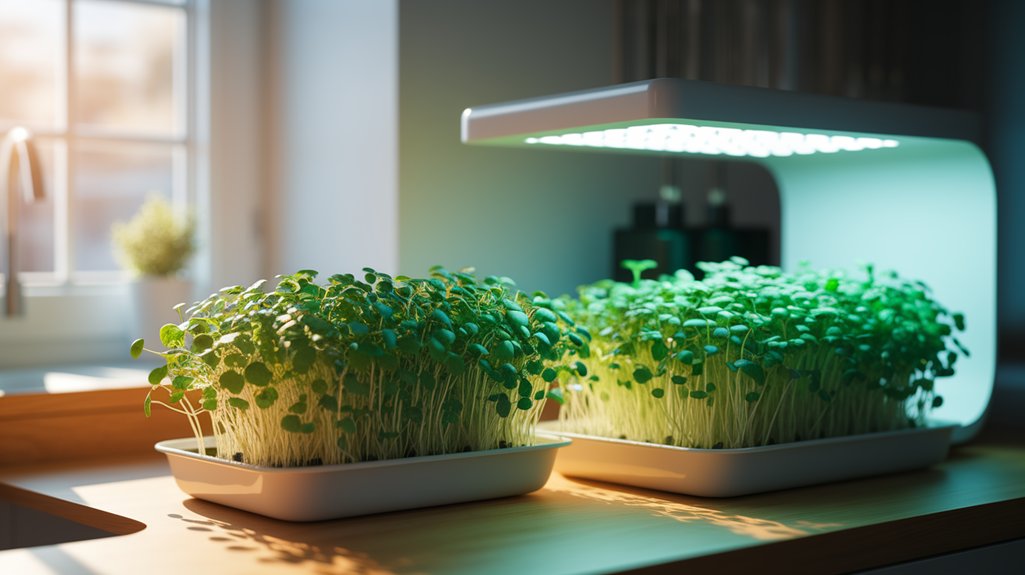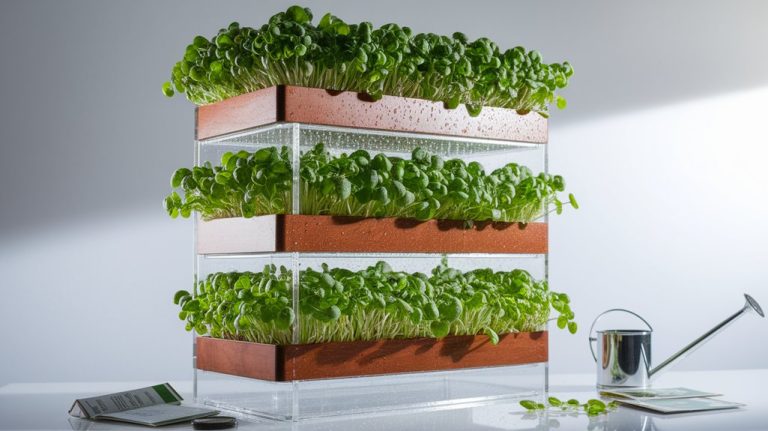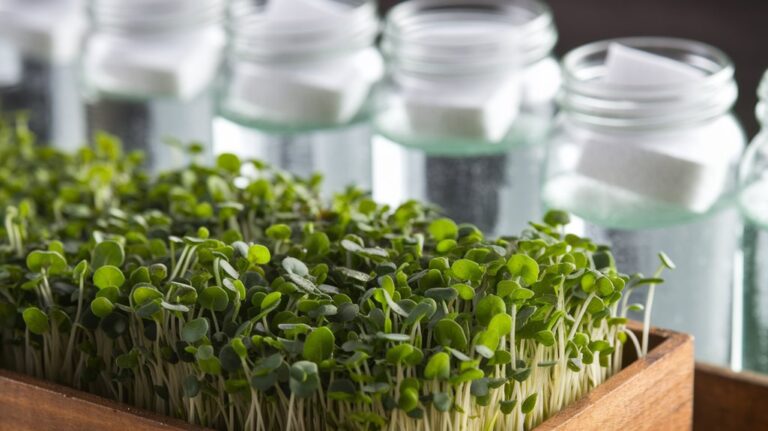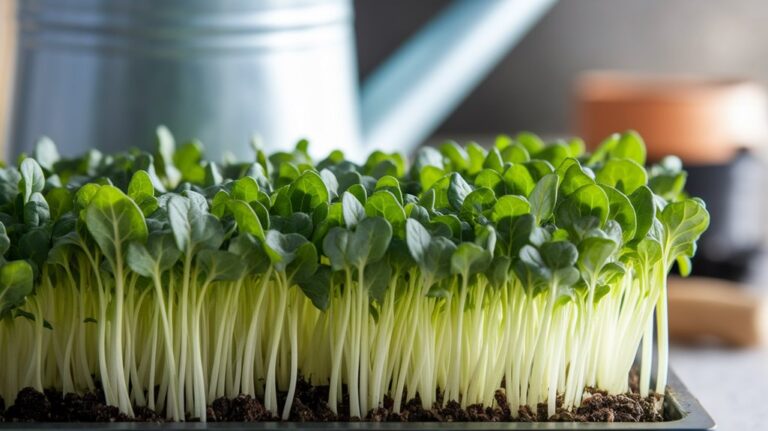Lighting for Microgreens: Natural vs. Grow Lights Explained
When growing microgreens, I’ve found that both natural sunlight and grow lights have unique advantages. Natural sunlight provides a full spectrum essential for flavor development and reduces energy costs, while grow lights enable year-round cultivation and control over light intensity and duration. Higher light intensity from grow lights can accelerate growth and yields, making them a reliable option. If you want to learn how to optimize light exposure for thriving microgreens, there’s more to explore.
Key Takeaways
- Microgreens benefit from both natural sunlight and grow lights, each offering distinct advantages for optimal growth and flavor development.
- Natural sunlight provides a full spectrum of light, promotes richer flavors, and reduces energy costs.
- Grow lights allow for precise control over light spectrum and duration, ensuring consistent growth regardless of weather conditions.
- Higher light intensity from grow lights accelerates photosynthesis, leading to faster growth rates and increased yields.
- Although grow lights have upfront costs, they can enhance profitability through improved growth and reduced reliance on seasonal changes.
Understanding Microgreens and Their Light Requirements
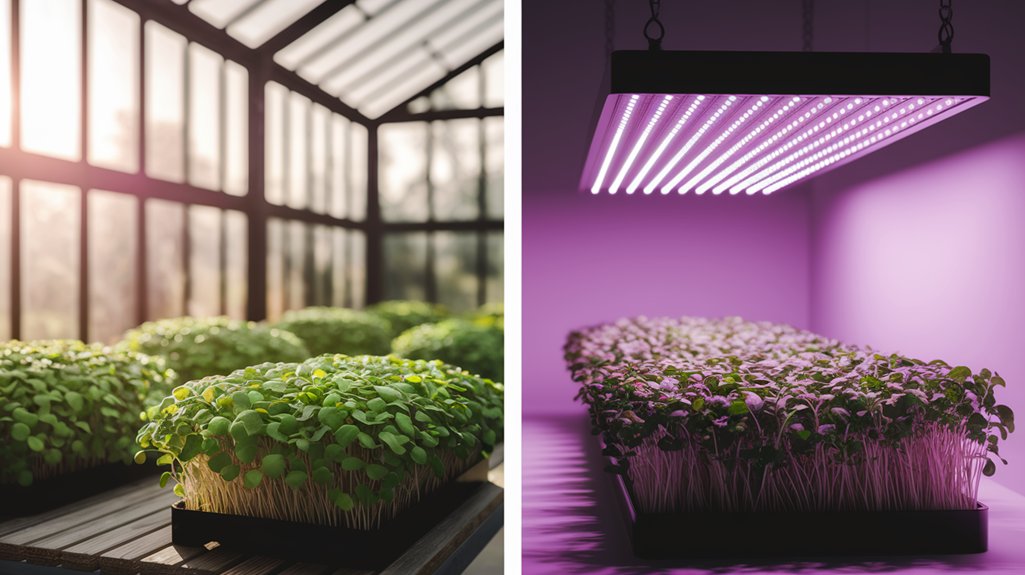
When I first began growing microgreens, I quickly realized that understanding their light requirements is crucial for healthy growth. Microgreens thrive on a spectrum of light, particularly in the blue and red wavelengths, which promote photosynthesis and robust development.
I found that providing 12 to 16 hours of light daily yields the best results. If you’re using artificial lights, full-spectrum LED grow lights are ideal because they mimic natural sunlight. It’s important to position the lights about 12 to 24 inches above the microgreens to prevent leggy growth due to insufficient light intensity.
I also learned that adjusting the light duration based on growth stages can enhance the flavor and nutrient density of the microgreens. Proper lighting, therefore, is a key factor in successful cultivation.
The Benefits of Natural Sunlight
While many growers rely on artificial lighting, I’ve found that utilizing natural sunlight can significantly enhance the growth and flavor of microgreens.
Here are some key benefits I’ve experienced:
- Optimal Spectrum: Natural sunlight provides a full spectrum of light, crucial for photosynthesis and vibrant growth.
- Cost-Effective: Using sunlight reduces energy costs associated with artificial lighting, making it easier on the wallet.
- Flavor Enhancement: Microgreens grown in natural light often develop richer flavors, attributed to the balanced light exposure.
- Sustainable Growth: Harnessing sunlight aligns with sustainable practices, minimizing the carbon footprint of your growing operation.
The Advantages of Using Grow Lights
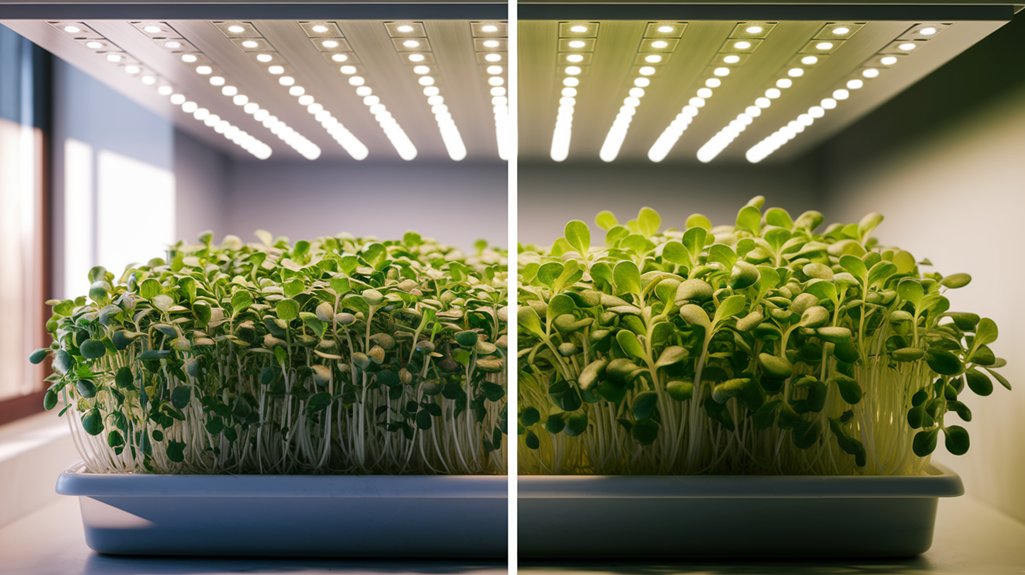
Although I appreciate the benefits of natural sunlight, I’ve found that using grow lights offers several distinct advantages for cultivating microgreens, especially when consistent and controlled growth is essential.
First, grow lights provide the ability to regulate the light spectrum, allowing me to optimize conditions for photosynthesis. For instance, specific wavelengths like blue light encourage leaf development, while red light enhances flowering.
Additionally, grow lights eliminate dependency on weather, enabling year-round cultivation regardless of seasonal changes. I can also manipulate the light duration, ensuring my microgreens receive the recommended 12-16 hours of light daily, which promotes healthy growth.
Lastly, grow lights can be positioned closer to the plants without the risk of burning, maximizing light exposure and improving overall yields.
Comparing Growth Rates and Yields
Using grow lights not only enhances the growing environment but also significantly impacts growth rates and yields of microgreens.
I’ve seen firsthand how the right lighting can transform my harvest. Here are four crucial factors that contribute to this improvement:
- Light Intensity: Higher light intensity accelerates photosynthesis, leading to faster growth.
- Light Spectrum: Specific wavelengths boost chlorophyll production, enhancing overall health and yield.
- Duration of Light Exposure: Extended light periods can maximize growth potential without overstressing the plants.
- Temperature Control: Grow lights can maintain optimal temperatures, promoting consistent and vigorous growth.
Cost Considerations for Lighting Options
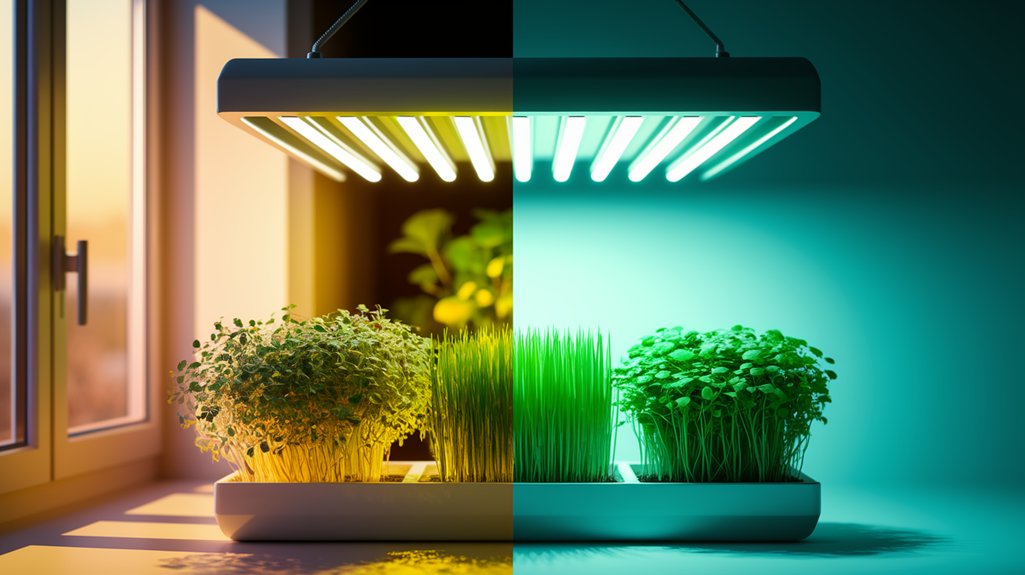
When I evaluate the various lighting options for my microgreens, cost considerations play a pivotal role in my decision-making process.
Initially, I look at the upfront costs, comparing natural light, which is free, to grow lights that can range from affordable fluorescent bulbs to pricier LED systems.
However, I also factor in energy consumption; LED lights, while more expensive initially, often save money over time due to lower electricity bills.
Additionally, I consider maintenance costs—some systems require more frequent bulb replacements or additional cooling.
Lastly, I analyze the potential yield increase from each option. Investing in better lighting can lead to higher quality and faster growth, ultimately offsetting initial costs and enhancing my microgreen business’s profitability.
Tips for Optimizing Light Exposure in Your Microgreen Garden
To achieve optimal light exposure in my microgreen garden, I focus on several key strategies that enhance growth and yield.
Here are four essential tips I’ve found effective:
- Positioning: I place my microgreens close to the light source, ensuring they receive maximum intensity without overshadowing each other.
- Duration: I provide 12-16 hours of light daily, mimicking natural sunlight cycles to promote rapid growth.
- Light Spectrum: I utilize full-spectrum grow lights, which deliver the necessary wavelengths for photosynthesis, leading to vibrant greens.
- Rotation: I rotate my trays regularly to ensure even light distribution, preventing leggy growth and promoting uniformity.
Frequently Asked Questions
Can I Use Regular Household Bulbs for Growing Microgreens?
I’ve tried using regular household bulbs for growing microgreens, and while they can provide some light, they usually lack the intensity and spectrum that plants need.
Standard bulbs emit more yellow and red light, which isn’t optimal for photosynthesis.
Instead, I recommend using full-spectrum LED grow lights, as they offer the right balance of blue and red wavelengths, ensuring my microgreens thrive and grow robustly.
It’s definitely worth the investment!
How Long Should I Leave Grow Lights on Each Day?
I usually leave my grow lights on for about 12 to 16 hours each day. This duration mimics natural sunlight and helps my microgreens thrive.
I’ve found that consistency is key; setting a timer ensures they get the right amount of light without me having to remember.
Just be mindful not to overexpose them, as too much light can stress the plants. Adjusting the duration based on their growth stage works well, too!
Do Microgreens Need Complete Darkness at Any Point?
I’ve found that microgreens don’t necessarily need complete darkness, but they do benefit from a period of rest.
I usually give them a few hours of darkness each day, which helps them grow stronger and encourages healthier development.
This balance mimics natural light cycles and promotes photosynthesis during light hours.
What Types of Microgreens Are Best for Indoor Growth?
When I grow microgreens indoors, I find that varieties like kale, radish, and basil thrive the best.
These types aren’t only hardy but also adapt well to contained environments. I love how quickly they germinate and grow, often within a week.
Additionally, they require minimal space, making them perfect for indoor setups.
I recommend experimenting with different seeds to see which ones suit your taste and growing conditions the best.
Can I Supplement Natural Light With Grow Lights?
Absolutely, I can supplement natural light with grow lights!
I often use grow lights to extend the light exposure, especially during shorter days or cloudy weather. By positioning the lights about 12-24 inches above my microgreens, I ensure they receive adequate light intensity while preventing overheating.
I also choose full-spectrum LED grow lights, as they mimic natural sunlight, promoting healthy growth. This combination really boosts my indoor microgreens’ vitality and yield!
Conclusion
In conclusion, choosing between natural sunlight and grow lights for microgreens depends on various factors, including your growing environment and specific crop needs. While natural sunlight is cost-effective and ideal for outdoor setups, grow lights offer consistent and adjustable conditions for indoor growing. By understanding the unique light requirements of your microgreens and optimizing exposure, you can significantly enhance growth rates and yields. Ultimately, the right lighting choice can lead to a thriving microgreen garden that meets your goals.

